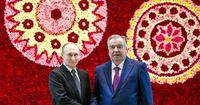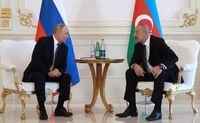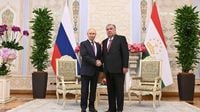Russian President Vladimir Putin touched down in Dushanbe, Tajikistan, on October 8, 2025, kicking off a closely watched state visit that puts the spotlight on shifting alliances and diplomatic maneuvering across Central Asia and the South Caucasus. As reported by TASS and Reuters, Putin’s arrival marks the start of a packed agenda—one that will see him engage with regional leaders and attempt to reassert Moscow’s influence in the face of mounting competition and regional instability.
Putin’s visit comes at a time when Russia’s traditional sway over its post-Soviet neighbors is under pressure. The Kremlin, according to Reuters, has been keen to strengthen ties with Central Asian states and forestall the return of instability in a region historically fraught with border disputes and internal rivalries. The Russian leader’s travel has been restricted in recent years due to an International Criminal Court arrest warrant over alleged war crimes in Ukraine, but this has not stopped him from ramping up diplomatic outreach to Russia’s Asian neighbors, including forging a “no limits” partnership with China and expanding cooperation with North Korea.
Upon arrival, Putin was greeted by Tajik President Emomali Rahmon at the Palace of Nations in Dushanbe. The two leaders wasted no time in reaffirming their countries’ relationship, holding an informal meeting on the evening of October 7 before proceeding to more formal talks the following day. As TASS reported, Rahmon was quick to underline the positive trajectory of bilateral ties: “Our relations are developing positively. We maintain an active political dialogue. Cooperation in trade, the economy, and cultural and humanitarian spheres is developing.”
The significance of Putin’s visit extends well beyond Tajikistan’s borders. On October 9 and 10, Dushanbe will host a series of major summits: a Russia-Central Asia summit, a meeting of the Commonwealth of Independent States (CIS) Council of Foreign Ministers, and the broader CIS summit itself. The gatherings will bring together leaders from Kazakhstan, Kyrgyzstan, Turkmenistan, Uzbekistan, Armenia, Azerbaijan, and Belarus, in addition to Russia and Tajikistan. As reported by Armenpress and Reuters, the Armenian government had yet to confirm Prime Minister Nikol Pashinyan’s participation as of October 9, adding a measure of uncertainty to the proceedings.
One of the most anticipated side events of the summit is the planned bilateral meeting between Putin and Azerbaijani President Ilham Aliyev. According to TASS and Kremlin spokesperson Dmitry Peskov, the two leaders agreed to meet in Dushanbe following a phone call on October 7, where they discussed regional developments and avenues for cooperation. This meeting is especially noteworthy given the recent turbulence in Russia–Azerbaijan relations, sparked by Azerbaijan’s 2023 military operations in Nagorno-Karabakh and the subsequent withdrawal of Russian peacekeepers earlier in 2025.
The upcoming Putin–Aliyev talks are expected to focus on stabilizing bilateral ties, with attention to cooperation in the energy and transport sectors, as well as broader regional security issues. As Sana Khan reported, the leaders are also likely to address the ongoing Armenia–Azerbaijan peace process and Russia’s potential future role in border stabilization. The meeting is seen as an effort by Moscow to retain a strategic foothold in the South Caucasus, even as its influence faces growing competition from Turkey and Western powers.
For Azerbaijan, the dialogue with Russia offers an opportunity to secure political assurances from Moscow while continuing to cultivate partnerships with Turkey—especially in the context of the Zangezur Corridor and other regional connectivity initiatives. The talks are also set against the backdrop of Azerbaijan’s efforts to consolidate its territorial gains following the 2023 conflict and to balance relations between Moscow, Ankara, and the West.
Tajikistan’s role as host is itself a reflection of the country’s ambition to serve as a neutral platform for post-Soviet diplomacy. The choice of Dushanbe for these high-level meetings underscores Tajikistan’s strategic importance and its desire to be seen as a reliable interlocutor amid regional realignments. According to TASS, President Rahmon and his administration have prioritized active political dialogue and the development of cooperation across multiple spheres, including trade, the economy, culture, and humanitarian affairs.
The broader context of the summit is defined by a complex web of interests and anxieties. Russia, preoccupied with the ongoing war in Ukraine and the resulting international isolation, is eager to prevent further erosion of its regional influence. As Reuters notes, Moscow is particularly concerned about the several million migrant workers from Central Asia who earn their livelihoods in Russia, sending vital remittances back home. The stability of these migrant flows, and the economic ties underpinning them, are expected to be a recurring theme in discussions.
At the same time, Central Asian countries like Kazakhstan have been treading a careful path, balancing their historical ties with Moscow against the need to maintain autonomy and diversify partnerships. Kazakhstan, for example, has taken a nuanced stance on Russia’s actions in Ukraine, reflecting the broader trend of regional states seeking to avoid over-dependence on any single power.
Security concerns remain front and center. Russia’s Defense Minister Andrei Belousov, as reported by Reuters, held talks with his Tajik counterpart Emomali Sobirzoda on October 8, emphasizing the importance of military cooperation for maintaining stability in Central Asia. “A lot today depends on cooperation between our two military institutions, most importantly, stability in Central Asia,” Belousov was quoted as saying. “The current situation remains very difficult.”
Looking ahead, the outcomes of the Dushanbe meetings could set the tone for regional diplomacy in the months to come. Analysts will be watching closely to see whether the talks between Putin and Aliyev result in concrete agreements or remain symbolic gestures amid Moscow’s constrained diplomatic capacity. The fate of the Armenia–Azerbaijan peace process, the future of Russian involvement in border security, and the broader question of how post-Soviet states navigate a world of shifting power dynamics are all in play.
For now, Tajikistan’s capital has become the stage for a high-stakes diplomatic dance, with leaders from across the former Soviet space converging to negotiate, recalibrate, and—perhaps—forge a new path forward in a region where history is never far from the negotiating table.



